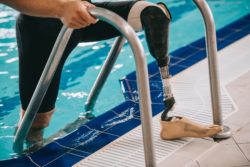 Certain type-2 diabetes medications have been linked to an increased risk of diabetic leg amputation. According to a recent study, Farxiga and other SGLT2 inhibitors may double to the risk of lower limb amputation.
Certain type-2 diabetes medications have been linked to an increased risk of diabetic leg amputation. According to a recent study, Farxiga and other SGLT2 inhibitors may double to the risk of lower limb amputation.
According to a recent study in BMJ conducted by Dr. Peter Ueda, a postdoctoral researcher with Karolinska University Hospital in Stockholm, and his colleagues found that SGLT2 inhibitors significantly increased the likelihood of the need for diabetic leg amputation. This study consisted of 17,213 patients prescribed SGLT2 inhibitors and 17,213 GLP1 receptor agonists, between July 2003 and December 2016.
There were a number of factors in trying to control the large subject groups, including factoring other medical problems or medications that patients may have been taking. Researchers ultimately found that SGLT2 patients faced double the risk of lower limb amputation compared to GLP1 receptor agonists.
Findings were published on Nov. 14, 2018 in the BMJ medical journal, and is the first study reporting a correlation between Farxiga and increased amputation risk. SGLT2 inhibitor side effects have been under scrutiny as of late.
The medical community is currently calling for further research, with patients at the highest risk consisting of older obese male patients along with patients with pre-existing circulation problems like peripheral artery disease.
Overview of SGLT2 Inhibitors and Lower Limb Amputation
Farxiga (dapagliflozin) was approved by the FDA on Jan. 8, 2014, which is often prescribed to type-2 diabetes patients for glycemic control assistance.
Like other SGLT2 inhibitors, Farxiga works by expelling excess sugar through urination. Along with diet and exercise, Farxiga and other SGLT2 inhibitors are supposed to minimize the risk of serious diabetic complications like heart attack or stroke.
However, recent research suggesting these medications significantly increase the risk of diabetic leg amputation has left the public concerned. Type-2 diabetes patients contend with a variety of health problems due to having issues with insulin production, which can also make circulation difficult in lower limb amputation.
Research suggested that SGLT2 inhibitors may increase circulation problems, due to the way excess sugar passes through urination. These medications may cause patients to urinate more frequently, which causes them to become dehydrated and decreasing blood supply.
This can make circulation problems even worse in type-2 diabetes patients, which can lead to reducing sensation and severe nerve damage. When circulation becomes disrupted, nerves can die and it becomes more difficult for patients to use their lower limbs. The risk of ulcers, infections, and tissue death significantly increases as well, with it likely to spiral downward in a negative feedback loop.
Feet are considered the most at risk because injuries can develop into an infection or ulcer but can go unnoticed due to the lost sensation.
Under these circumstances, lower limb amputation might become necessary for the patient’s quality of life. However, patients should be warned if their treatment medications come with any significant side effects. Farxiga manufacturer AstraZeneca may have failed to properly disclose a potentially increased risk of lower limb amputation, which could cause them to be liable for some patients’ injuries.
If you or a loved one experienced diabetes amputation after taking Jardiance or Farxiga, you may have a legal claim and may be eligible to seek compensation from the drug maker for your medical and other expenses. Fill out the form on this page now to see if you qualify!
ATTORNEY ADVERTISING
Top Class Actions is a Proud Member of the American Bar Association
LEGAL INFORMATION IS NOT LEGAL ADVICE
Top Class Actions Legal Statement
©2008 – 2026 Top Class Actions® LLC
Various Trademarks held by their respective owners
This website is not intended for viewing or usage by European Union citizens.
Get Help – It’s Free
Join a Free Jardiance, Farxiga Diabetes Amputation Class Action Lawsuit Investigation
If you qualify, an attorney will contact you to discuss the details of your potential case at no charge to you.
If you took Invokana or Invokamet, you do not qualify for this investigation. Click here to join a separate class action lawsuit investigation.
PLEASE NOTE: If you want to participate in this investigation, it is imperative that you reply to the law firm if they call or email you. Failing to do so may result in you not getting signed up as a client or getting you dropped as a client.
E-mail any problems with this form to:
[email protected].
Oops! We could not locate your form.












